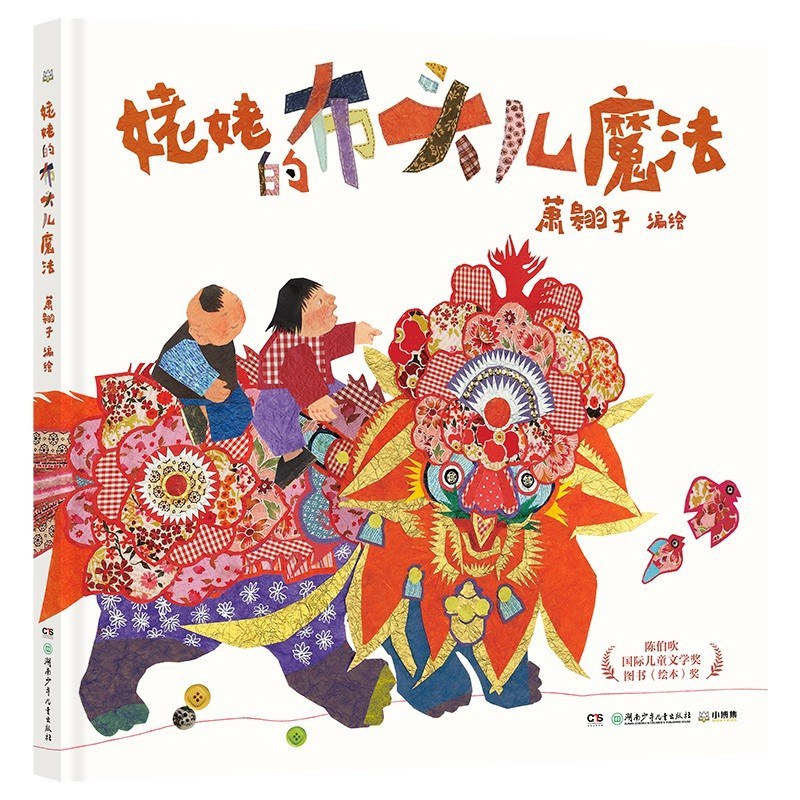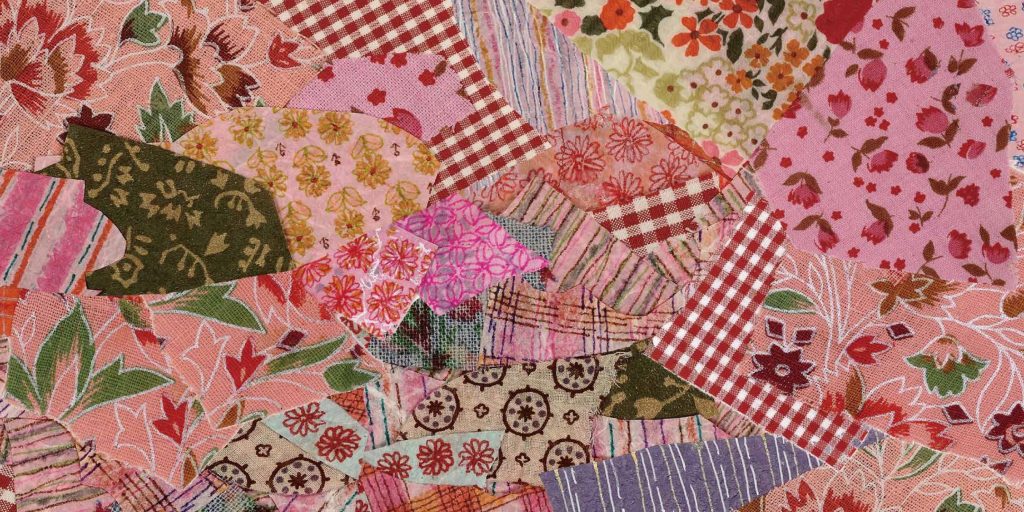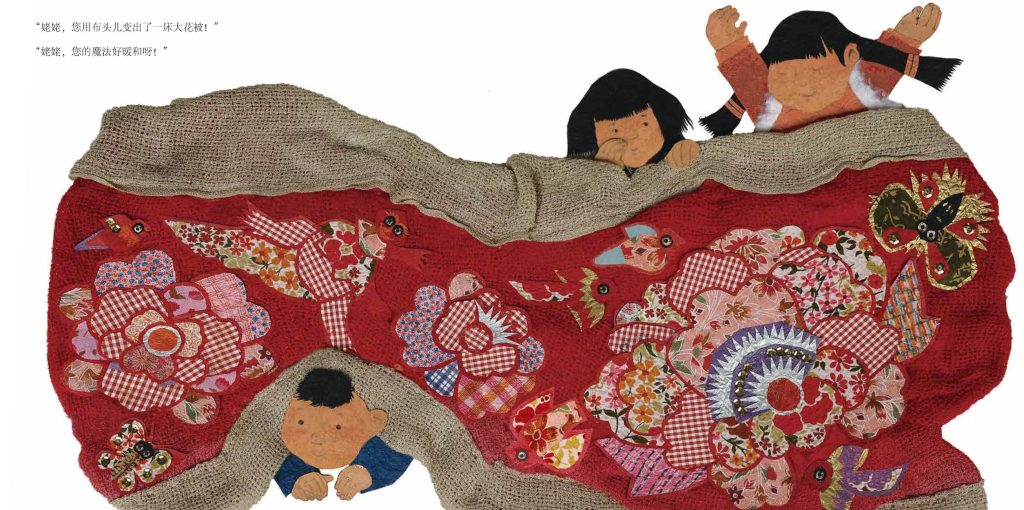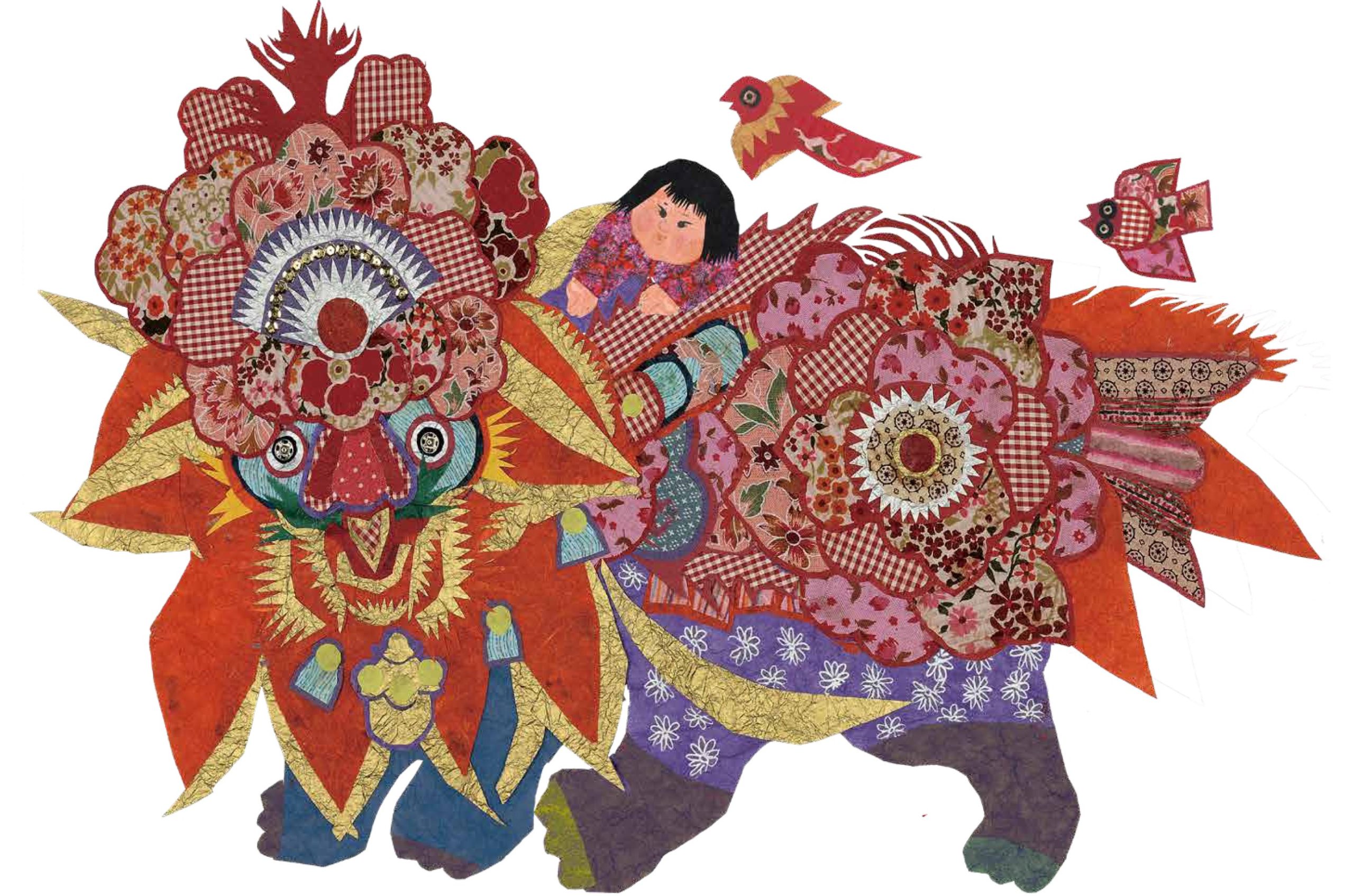“Grandma’s Cloth Magic” is a paper patchwork art exhibition full of childlike fun. Through the interaction between the “magic” grandma and three children, it shows the magical effect of the combination of traditional patchwork handicrafts with children’s art and modern art.

Although the grandmother in the book kept the small oil lamp on the kang lit when she performed magic, the small needle holders, little lions, small bellybands, small cloth shoes, tiger-head hats, small cotton-padded jackets, cloth door curtains, large quilts… which she made with cutting and sewing techniques are also traditional objects, but the way they are presented is an artistic composition that collages together different graphics, photos, and real objects, which is exactly the same as the way Eric Carle presented “The Very Hungry Caterpillar”. Aozi also maintained his usual naive and warm style when showing these cloth magic, making this heartwarming exhibition full of lively modern atmosphere.
From the perspective of possible narrative realism, the small oil lamp in the book is actually quite “suspicious.” It’s difficult to find such a lamp in today’s world, let alone for Grandma to use as a light while mending. The funniest part is that when the children decide to imitate Grandma’s magic tricks with needle and thread and scraps of cloth, they also use the small oil lamp for lighting! This obviously can’t be a realistic narrative. The burning oil lamp here is a symbolic symbol, representing the continuation of a tradition, the hope that it will be passed on to the next generation.
The art of patchwork, known as “patchwork” in English, showcased in this book, has a long and rich history worldwide. Many foreign picture books feature patchwork quilts, the most representative of which is Boracow’s “Heirloom Quilts,” which explores Jewish traditions. These patchwork quilts, passed down from generation to generation, carry a family’s history, traditions, and bonds. “Grandma’s Cloth Magic” showcases the unique qualities of traditional Chinese patchwork craft, where patterns and colors often hold special meanings. For example, the overall color palette favors red, often signifying auspiciousness. Children’s items often feature designs like lions, tigers, pigs, and fish, apparently meant to ward off evil and bring blessings, wishing for longevity, plenty, and prosperity year after year.

Throughout the long history of Chinese patchwork, its development and inheritance have been closely intertwined with daily life, festivals, and religious beliefs. For example, the “patchwork robes” worn by monks symbolize frugality and self-cultivation. Meanwhile, the folk custom of stitching clothing together from irregular scraps of cloth stemmed from poverty and a thrifty culture. Later, sewing “hundred-family clothes” for children, using scraps of cloth collected from friends, relatives, and neighbors, became more of a symbol of blessing for the child, allowing them to enjoy food and wear clothes from a variety of families. As economic conditions improved, fabric selection became increasingly sophisticated, and more complex techniques like embroidery were incorporated into the crafts, resulting in meticulously crafted items that are both practical and beautiful, possessing both utilitarian and artistic value. For example, Dabujiang patchwork embroidery, which has been designated a Hunan Provincial Intangible Cultural Heritage, exemplifies this popular folk art form, a form of indigenous plastic art that is also exported internationally.
As the author, Aozi, states, this book aims to convey more than just the concept of “cherishing things.” In an age of rampant consumerism, people may gradually lose their ability to discover and appreciate beauty, a truly concerning fact. When people view only consumed items as trash, not only does this contribute to waste and pollution, it can also gradually diminish their ability to appreciate the beauty of creation. When an artist transforms a vast expanse of plastic waste salvaged from the ocean into a beautiful whale sculpture, viewers reconsider the very definition of “trash.” Grandma’s magic with scraps of cloth may not be as impactful, but it does offer a perspective that allows children and adults alike to rethink the discarded bits and pieces of life. When we develop an eye for beauty and a willingness to cultivate our hands to create, even discarded items like scraps of cloth can become the material for artistic creation. This ability can be cultivated from the earliest childhood.
“Grandma’s Cloth Magic” is filled with hope for children. The first half of the book focuses on Grandma demonstrating her exquisite patchwork skills, sparking the children’s intense interest and making them eager to try their hand at it. While children certainly can’t master such complex crafts quickly, their most powerful skill is their unconventional imagination. The patchwork pieces in the second half of the book are born from childlike imagination. Unlike the practical crafts in the first half, these are essentially “useless” objects, at most just children’s toys. However, it is precisely this passionate and unrestrained imagination that allows people to feel the magic and beauty of life.

When reading picture books like this with children, why not engage in more of an experiential and artistic enjoyment, as if attending a special patchwork art exhibition together? While admiring the artwork, you can discuss the stories and potential meanings of each small artifact. For example, what is the “Eight Children Holding Fortune” pincushion? Why is the small bellyband so auspicious? Why is the tiger hat so majestic? Why are the pig shoes so adorable? What are the patterns on the door curtains and flower quilts? Adults and children can interpret the patterns together. As long as there are no standard answers, children will express themselves freely. If possible, you can also invite children to help with their hands-on activities, not necessarily with needlework. Have them draw their own little lions, large door curtains, or flower quilts, or use colored paper to collage a small trailer or a house in the clouds…
Given the opportunity, every child can become an artist who can perform magic!
Written in Beijing on July 12, 2023
